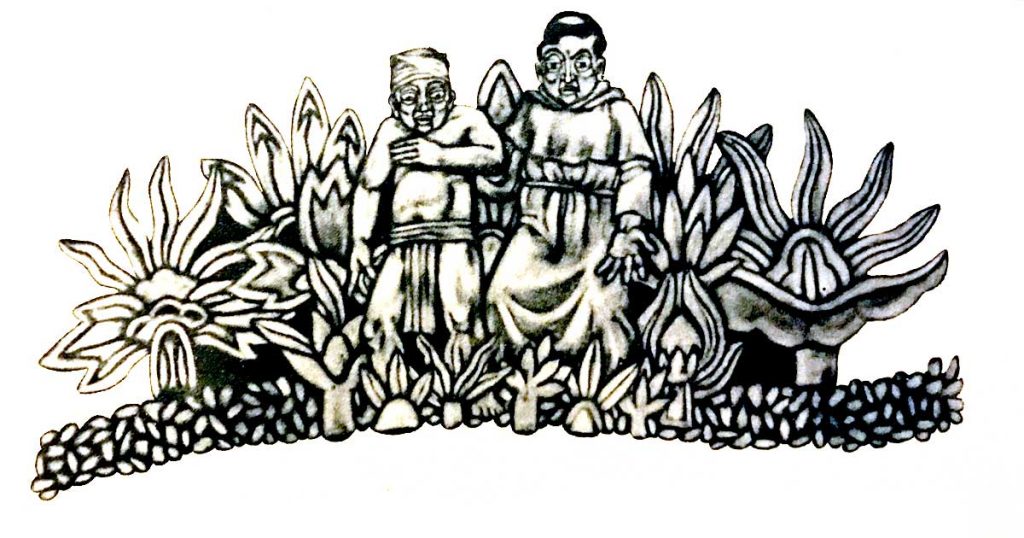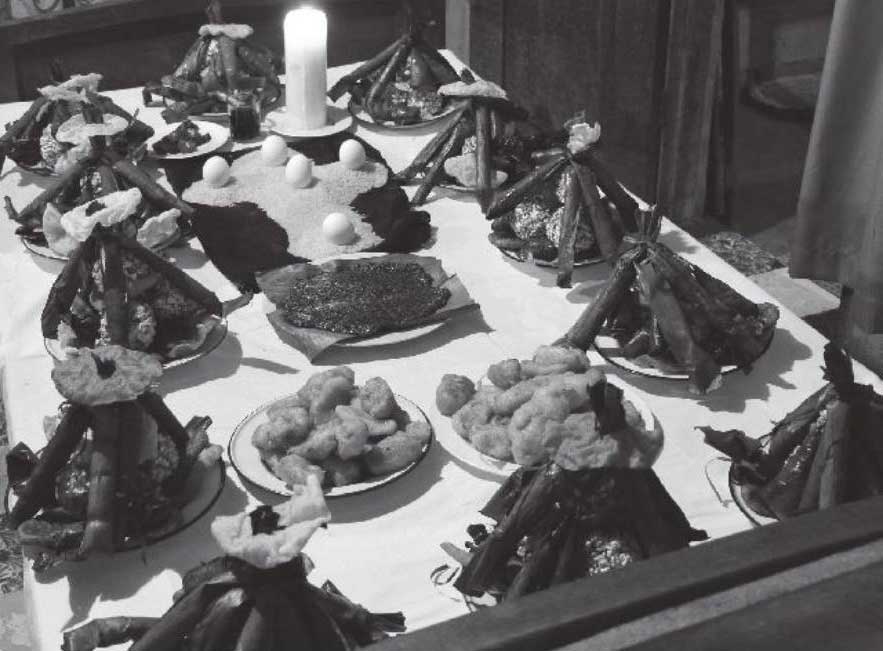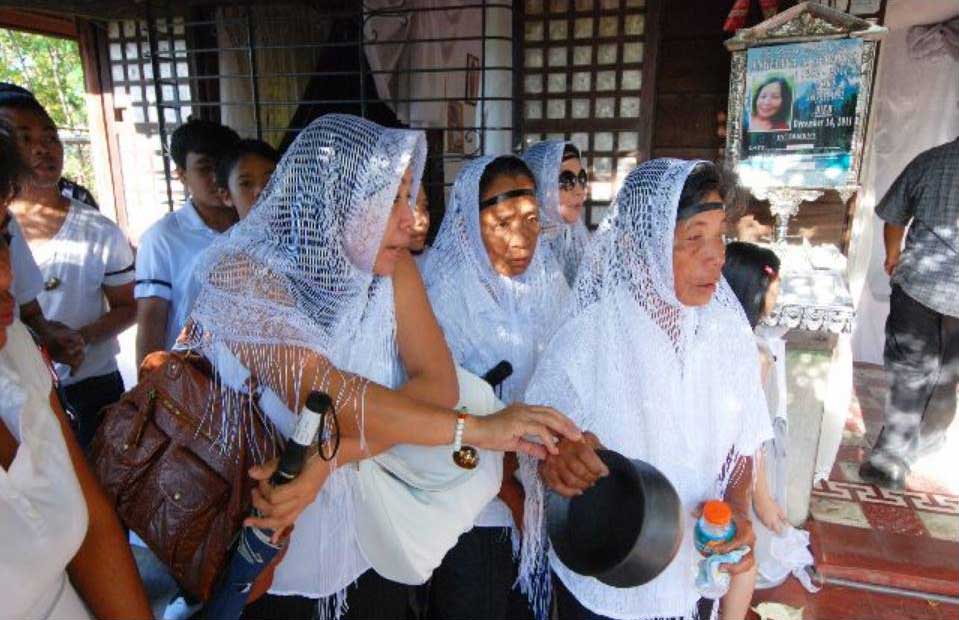The present lloko population is basically Christian. Majority belongs to the Roman Catholic Church. The rest are affiliated with other Christian denominations such as the Iglesia Filipina lndependiente, Iglesia ni Cristo, Baptist Church, Methodist Church, Jehovah’s Witnesses, and Church of the Latter Day Saints. Contemporary lloko religiosity is nevertheless largely a syncretism of the above institutions’ influences and indigenous beliefs. Only the few members of more fundamentalist religious sects which have sprouted in the last decade or so no longer practice indigenous rituals. By looking at modern practices, we can strip away the organized religious aspects and gain a stronger understanding of precolonial practices that may have occurred in the region. Among the Ilokanos, there are plenty.
Apart from believing in Apo Dios (Lord God) as Supreme Being, llokanos are still very much into ancestor worship and at a lesser level, animism. They have high regard for, and always commemorate, the kararwà dagitì natay (spirit/soul of the dead). They believe that these dead ancestors can inflict harm on them if the living do wrong and if they forget the dead. More importantly, they think that now being “nearer to God;’ the dead can intercede for the living in imploring God to grant their wishes. Thus, seeking favors from the dead is almost as necessary as praying to Apo Dios. As pangilàglagìp kadagitì kararwà (commemorating the souls), church masses and novenas are offered at certain occasions like the dead’s birth and death anniversaries.
Apart from earth-bound kararwà, an-anito or katao-tao-àn (supernatural beings) are also believed to inhabit the environment. Certain trees and plants are, for example, associated with certain anito.

used with permission
DEATH PRACTICES
Whether it is due to old age, illness, accident, or harm inflicted upon by another person (e.g. murder), death is accepted as gasat(fate) or as nakem ti Apo (God’s will). However, murder, illness, and death believed to have been caused by a manggagamud (sorcerer), evoke a feeling of hatred towards the suspect and his/her family. Such often lead to disputes, and though in rare instances, to binnales (a cycle of revenge).
In earlier times, interment was held either on the same day that the person died or on the following day, thus holding a wake of two days and one night at most. The wakes became longer – from four days to more than a week – when embalming was introduced. All throughout the wake, a temtém (small bonfire) is kept at the entrance of the house where the wake is held. Coffee, snacks, and meals are served during the wake, depending on how much can be afforded by the family or on what has been donated by sympathizers.

IMAGE: ICHCAP ICH Digital Archives
When the dead is a victim of murder, a chick is placed on top of the coffin the whole time of the wake supposedly to keep the dead seeking for justice as well as to continuously haunt the culprit.
The kin and the entire community are expected to makiminatày or makidilangit (“share in the grief”) and to pay their respects to the dead at least once throughout the wake. They also extend their arayat, be it in cash or kind. The closest relatives and neighbors usually stay around the nagminatay (bereaved family) during the wake, taking turns to do the housework for the latter.
By custom, the immediate members of the family of the dead (parents, siblings, spouse, children) are not allowed to work while the wake is held. They are not to cook because seeing fire is believed to cause poorer eyesight later. They are not to carry heavy objects, especially over the head, because this will supposedly weaken their (neck) bones and lead to involuntary shaking of the head in later age. And they are not also allowed to take a bath until the burial (understandably, such was possible because the wake only took two days at most; this custom is no longer strictly followed today). Moreover, sweeping by anyone inside the house and yard is prohibited, and the bereaved are not to usher visitors out of the house.
Family members and other relatives of the dead perform the dung-àw throughout the wake, especially when the wake has just started, at night, and before the dead is buried. Kin who just arrived go directly near the coffin to do the dung-àw after condoling with those present at the wake. The dung-aw involves chanting while crying. It is where the history, good deeds, and even weaknesses of the dead person are recounted. It also contains the experiences shared between the dead person and the one doing the dung-àw and gives the opportunity for the relative or friend to beg for forgiveness of the dead for any wrong done on the latter. The longest and most touching dung-àw could be heard from the parents, especially the mother who may narrate events from the time of conception to the last moments of her child. At present, though, the dung-àw is rarely heard in the urban areas and is slowly vanishing even in the rural areas.

IMAGE: ICHCAP ICH Digital Archives
When the coffin is carried out of the house for the burial, a rooster is killed, by piercing its neck and letting it run around in the yard. This is done supposedly because the rooster’s spirit will accompany the spirit of the dead in the next life. Almost always, the dead is brought to the church for the last rites, wherein a mass for and blessing of the dead is undertaken by a priest or minister. The bereaved family members kiss the hands of the dead and everyone is enjoined to offer flowers either before the dead is brought out of the house or immediately after the church rites. The family and community join together in a procession following the dead – from the home to the church, then from the church to the cemetery. The spouse of the dead is immediately brought home after the church rites, prohibiting him or her to attend the actual interment as he or she may follow in death soon.
Before the interment, it is ascertained that the dead person is not wearing shoes or slippers because this may cause the bereaved members to hear his footsteps when his spirit visits the family. The metal cross (and sometimes, all metals) in the body of the dead is also removed. It is however ensured that extra clothes, footwear, some coins, and some of the favorite things of the person when he was still alive are buried with him, in order for him to have something to use in the afterlife. The dead is then covered with a white blanket from head to foot so that he “may not feel cold:’ The participants in the funeral then place objects on the coffin, mostly a handful of earth or some flowers, after it is laid down in the ground or interred inside the tomb.
After the interment, all the participants of the funeral go to the home of the bereaved family to partake of the food served. Anyone who does not do so may be mabaros (haunted or afflicted with disease by the spirit of the dead).
The panaggulgól (hair-washing rite) for the immediate members of the bereaved family is held a day after the burial. Here, the said family members take a bath (near the home’s well, or any water source, or at the beach), their hair is washed by other relatives, but more preferably, by community members who are not related to the family. For Catholics, a nine-day novena for the dead and partaking of food commences immediately on the first day of the wake. The last day of this novena is made special by serving more food after the prayers are done. The kin and close neighbors also join the bereaved family in going to the river or beach to take a bath on the ninth day or during the
panaggulgól.

IMAGE: ICHCAP ICH Digital Archives
The kararwà (soul or spirit) of the dead is believed to linger on earth with his or her family for forty days from the time of death. On the fortieth day, the soul is believed to leave the earth for its destination in another plane. Another novena is held on this occasion, followed by another sharing of food. Although they are expected to visit their loved ones from time to time, only the kararwà who cannot find peace are believed to continue staying on earth. Victims of crimes and accidents, other untimely deaths or the dead who left behind serious problems are said to stay on and haunt the living until they have been appeased. When manifesting its presence to the living, the kararwà is referred to as al-alyà or aninga-as.
Coming together in grief, strained relationships in a family are often mended when a death occurs.
SOURCE: The Iloko, M.L.I. Ingel, National Commision for Culture and the Arts, 2006
ALSO READ: Ilokano Deities: Philippine Mythology
Jordan Clark is a Canadian born descendant of Scottish immigrants living on the homelands of the Lekwungen speaking peoples. His interest in Philippine myth and folklore began in 2004. Finding it difficult to track down resources on the topic, he founded The Aswang Project in 2006. Shortly after, he embarked on a 5 year journey, along with producing partner Cheryl Anne del Rosario, to make the 2011 feature length documentary THE ASWANG PHENOMENON – an exploration of the aswang myth and its effects on Philippine society. In 2015 he directed “The Creatures of Philippine Mythology” web-series, which features 3 folkloric beings from the Philippines – the TIKBALANG, KAPRE and BAKUNAWA. Episodes are available to watch on YouTube. Jordan recently oversaw the editing for the English language release of Ferdinand Blumentritt’s DICCIONARIO MITOLÓGICO DE FILIPINAS (Dictionary of Philippine Mythology) and is working on two more releases with fellow creators scheduled for release later this year. When his nose isn’t in a book, he spends time with his amazing Filipina wife of 20 years and their smart and wonderful teenaged daughter.


